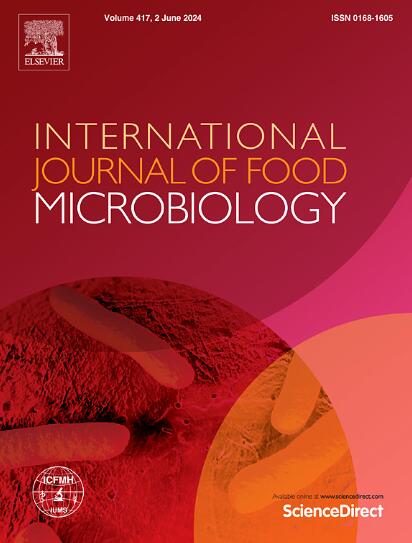Dynamics of mono and dual-species biofilms of Escherichia coli and Salmonella Typhimurium: Interspatial interactions and novel inhibition strategies
IF 5.2
1区 农林科学
Q1 FOOD SCIENCE & TECHNOLOGY
International journal of food microbiology
Pub Date : 2025-05-26
DOI:10.1016/j.ijfoodmicro.2025.111280
引用次数: 0
Abstract
Multi-species biofilms in the food industry present significant global health risks, contributing to frequent outbreaks, diseases, and fatalities. This study aimed to characterize the mono- and dual-species biofilms formed by invasive food isolates Escherichia coli EMC17 and Salmonella typhimurium SMC25, focusing on microbial load variations, interspecies interactions, and the exploration of a combinatorial inhibition strategy for biofilm disruption. The highest biofilm density was observed in dual-species cultures at equal inoculum after 96 h, as confirmed by Crystal Violet assay and exopolysaccharide (EPS) production (72 μg/ml). Dual-species biofilms showed total bacterial counts of 7.29 log10 CFU/cm2 for E. coli EMC17 and 5.95 log10 CFU/cm2 for S. Typhimurium SMC25, with both strains exhibiting strong multidrug resistance (MDR), as indicated by MAR indices of 0.46 and 0.38, respectively. Epifluorescence and confocal laser microscopy revealed synergistic interactions during dual-species biofilm development, further supported by principal component analysis, which highlighted distinct growth patterns between mono- and dual-species biofilms. Specifically, mono-species biofilms of E. coli EMC17 had a biovolume of 56.70 ± 1.36 μm3/μm2 at 96 h, whereas dual-species biofilms reached 62.61 ± 1.38 μm3/μm2. Additionally, dual-species biofilm-associated cells exhibited significantly enhanced adhesion (16.40 %) and invasion (2.07 %) potential compared to the mono-species biofilms. Furthermore, a combinatorial inhibition strategy using quercetin and citric acid demonstrated synergistic activity against the MDR strains, with fractional inhibitory concentration index (FIC) of <0.5. These findings offer new insights into the dynamics of dual-species biofilms, emphasizing the potential of phytochemical-citric acid combinations as promising alternatives to traditional antibiotics in biofilm management.

大肠杆菌和鼠伤寒沙门氏菌单种和双种生物膜的动力学:空间相互作用和新的抑制策略
食品工业中的多物种生物膜带来了重大的全球健康风险,导致频繁的疫情、疾病和死亡。本研究旨在表征入侵性食物分离菌大肠杆菌EMC17和鼠伤寒沙门氏菌SMC25形成的单种和双种生物膜,重点研究微生物负荷变化、种间相互作用以及探索生物膜破坏的组合抑制策略。结晶紫测定和胞外多糖(EPS)产量(72 μg/ml)证实,等接种量双种培养96 h后生物膜密度最高。双菌种生物膜显示,大肠杆菌EMC17和鼠伤寒沙门氏菌SMC25的细菌总数分别为7.29 log10 CFU/cm2和5.95 log10 CFU/cm2,两株菌株均表现出较强的多药耐药(MDR),其MAR指数分别为0.46和0.38。荧光和激光共聚焦显微镜显示了双物种生物膜发育过程中的协同作用,主成分分析进一步支持了这一结果,强调了单物种和双物种生物膜之间不同的生长模式。其中,大肠杆菌EMC17单菌种生物膜在96 h时的生物体积为56.70±1.36 μm3/μm2,双菌种生物膜的生物体积为62.61±1.38 μm3/μm2。此外,与单种生物膜相比,双种生物膜相关细胞表现出显著增强的粘附力(16.40%)和侵袭力(2.07%)。此外,槲皮素和柠檬酸的组合抑制策略对MDR菌株具有协同作用,分数抑制浓度指数(FIC)为0.5。这些发现为双物种生物膜的动力学提供了新的见解,强调了植物化学-柠檬酸组合作为传统抗生素在生物膜管理中有希望的替代品的潜力。
本文章由计算机程序翻译,如有差异,请以英文原文为准。
求助全文
约1分钟内获得全文
求助全文
来源期刊
CiteScore
10.40
自引率
5.60%
发文量
322
审稿时长
65 days
期刊介绍:
The International Journal of Food Microbiology publishes papers dealing with all aspects of food microbiology. Articles must present information that is novel, has high impact and interest, and is of high scientific quality. They should provide scientific or technological advancement in the specific field of interest of the journal and enhance its strong international reputation. Preliminary or confirmatory results as well as contributions not strictly related to food microbiology will not be considered for publication.

 求助内容:
求助内容: 应助结果提醒方式:
应助结果提醒方式:


